
- About Python language
- Python language features
- Who use Python ?
- How can we use python ?
- Graphical interface GUI in Python
- Main libraries and frameworks attached to the Python language
- Official documentation of Python
- Main python distributions with description
- Whre I can find the standard distribution
1. About Python language
- Python is a popular high-level, interpreted programming language that is easy to learn and understand. Created by Guido van Rossum in the late 1980s, Python emphasizes code readability and simplicity, making it an excellent language for beginners and experienced programmers alike.
- One of Python's strengths is its extensive standard library, which contains a wide range of modules for common programming tasks, such as web development, scientific computing, data analysis, machine learning, and more. Python's popularity has also led to the creation of a large ecosystem of third-party libraries and tools.
- Python uses indentation to indicate the structure of code blocks, making it easier to read and understand. It also has dynamic typing, which means that you don't need to declare variable types explicitly. Python supports both procedural and object-oriented programming paradigms and has functional programming features as well.
- Python is widely used in many fields, including web development, data analysis, scientific computing, artificial intelligence, machine learning, and automation. It's also a popular language for teaching introductory programming courses due to its simplicity and readability.
2. Python language features
Here are some of the key features of Python:
- Easy to learn and use: Python is known for its simple and easy-to-learn syntax, which makes it an excellent choice for beginners.
- High-level language: Python abstracts away many low-level details, making it easier to write and read code.
- Interpreted: Python code is executed line by line, and you don't need to compile it before running.
- Dynamically typed: Python doesn't require you to declare variable types, making it more flexible and allowing you to write code faster.
- Object-oriented: Python supports object-oriented programming, which allows you to create reusable code and improve code organization.
- Large standard library: Python comes with a large standard library, which provides many useful modules and functions for common tasks.
- Cross-platform: Python code can run on multiple platforms, including Windows, Linux, and macOS.
- Third-party libraries: Python has a vast ecosystem of third-party libraries and tools, making it easy to extend its functionality.
- Versatile: Python can be used for a wide range of applications, including web development, data analysis, scientific computing, machine learning, and more.
- Free and open-source: Python is free to use and distribute, and its source code is available to everyone, allowing for contributions and improvements from the community.
3. Who use Python ?
Python is widely used by developers, data scientists, researchers, and students around the world. Here are some of the organizations that use Python:
- Google: Python is one of the primary languages used at Google for various purposes, including automation, web development, and machine learning.
- Facebook: Python is used extensively at Facebook for backend web development and data analysis.
- NASA: Python is used by NASA for scientific computing, data analysis, and visualization.
- Netflix: Python is used by Netflix for recommendation systems, content analysis, and other data-driven tasks.
- Spotify: Python is used by Spotify for data analysis, backend development, and machine learning.
- Dropbox: Python is used by Dropbox for backend development, automation, and data analysis.
- Instagram: Python is used extensively by Instagram for backend web development, data analysis, and machine learning.
- Reddit: Python is used by Reddit for various purposes, including web development and data analysis.
- Mozilla: Python is used by Mozilla for various purposes, including web development and testing.
- IBM: Python is used by IBM for data analysis, machine learning, and other applications.
Python's versatility and ease of use make it an attractive choice for many different applications, from scientific computing to web development to artificial intelligence.
4. How can we use python ?
Python can be used in a wide range of applications, including:
- Web development: Python can be used for server-side web development using frameworks like Django, Flask, and Pyramid.
- Data analysis: Python has several powerful libraries for data analysis, including NumPy, Pandas, and Matplotlib.
- Scientific computing: Python is widely used in scientific computing for tasks such as simulations, modeling, and data visualization.
- Machine learning: Python has several popular libraries for machine learning, including Scikit-learn, TensorFlow, and PyTorch.
- Automation and scripting: Python can be used for automation tasks and scripting, making it useful for tasks such as system administration and data processing.
- Game development: Python can be used for game development using libraries like Pygame and Panda3D.
- Desktop application development: Python can be used for developing desktop applications using frameworks like Tkinter and PyQt.
- Internet of Things (IoT): Python can be used for IoT applications, such as controlling and monitoring sensors and devices.
- Artificial Intelligence: Python is widely used in artificial intelligence applications like natural language processing, computer vision, and robotics.
- Education: Python is a popular language for teaching introductory programming courses due to its simplicity and readability.
These are just some of the many applications of Python. With its versatility and extensive libraries, Python can be used for a wide range of tasks in many different industries.
5. Graphical interface GUI in Python
Python has several libraries and frameworks that can be used to create graphical user interfaces (GUIs). Here are some of the popular GUI libraries in Python:
- Tkinter: Tkinter is a standard Python library for creating GUI applications. It's easy to learn and comes with a set of widgets and tools for creating simple to complex GUIs.
- PyQT: PyQT is a popular library for creating GUI applications using the Qt framework. It provides a set of widgets, tools, and APIs for building modern and professional-looking applications.
- wxPython: wxPython is a cross-platform toolkit for creating GUI applications in Python. It's known for its native look and feel and provides a set of widgets, tools, and APIs for building applications.
- Kivy: Kivy is a cross-platform library for creating multi-touch applications. It supports various input devices like mouse, touchscreens, and other input devices.
- PySide: PySide is a Python binding for the Qt framework. It provides access to the Qt libraries, widgets, and tools for creating GUI applications.
- PyQtGraph: PyQtGraph is a fast and efficient library for creating interactive plots and visualizations. It provides a set of widgets and tools for creating real-time plots and visualizations.
These are just some of the popular GUI libraries available in Python. Each library has its strengths and weaknesses, and the choice depends on your requirements, experience, and project needs.
6. Main libraries and frameworks attached to the Python language
Python has a vast ecosystem of libraries and frameworks that extend its functionality and make it suitable for a wide range of applications. Here are some of the popular libraries and frameworks in Python:
- NumPy: NumPy is a popular library for numerical computing in Python. It provides support for multi-dimensional arrays, mathematical operations, and linear algebra.
- Pandas: Pandas is a popular library for data analysis and manipulation in Python. It provides support for data structures like data frames, time series, and various data operations.
- Matplotlib: Matplotlib is a popular library for data visualization in Python. It provides support for creating various types of plots like line charts, scatter plots, histograms, and more.
- Scikit-learn: Scikit-learn is a popular library for machine learning in Python. It provides support for various algorithms like classification, regression, clustering, and more.
- TensorFlow: TensorFlow is a popular library for machine learning and deep learning in Python. It provides support for building and training neural networks.
- Flask: Flask is a popular web framework in Python. It provides support for creating web applications using a lightweight and flexible approach.
- Django: Django is a popular web framework in Python. It provides support for creating complex and scalable web applications using a model-view-controller (MVC) architecture.
- Pygame: Pygame is a popular library for game development in Python. It provides support for creating 2D games using various features like graphics, audio, and input handling.
- Requests: Requests is a popular library for making HTTP requests in Python. It provides support for making HTTP requests, handling responses, and working with RESTful APIs.
- BeautifulSoup: BeautifulSoup is a popular library for web scraping in Python. It provides support for parsing HTML and XML documents and extracting data from them.
These are just some of the popular libraries and frameworks in Python. With its vast ecosystem, Python provides support for a wide range of applications and domains.
7. Official documentation of Python
The official documentation of Python is available on the Python website at https://docs.python.org. The documentation includes:
- Python Language Reference: This documentation provides a detailed description of the syntax and semantics of the Python language, including data types, operators, control structures, functions, classes, modules, and more.
- Python Standard Library: This documentation provides a detailed description of the modules and functions in the Python standard library. It includes modules for file handling, networking, threading, regular expressions, cryptography, and more.
- Python Tutorial: This documentation provides an introductory tutorial on the Python language. It covers the basics of Python programming, including data types, control structures, functions, modules, and more.
- Python How-To's: This documentation provides examples and solutions for common tasks in Python programming, including text processing, file handling, data analysis, networking, and more.
- Python FAQs: This documentation provides answers to frequently asked questions about Python programming, including installation, configuration, debugging, and performance.
- Python Glossary: This documentation provides a glossary of terms used in Python programming, including keywords, operators, data types, functions, and more.
The official documentation is an excellent resource for learning and using Python. It is comprehensive, up-to-date, and regularly maintained by the Python community.
8. Main python distributions with description
There are several distributions of Python available, each with its unique features and capabilities. Here are some of the main Python distributions with their descriptions:
- CPython: CPython is the reference implementation of the Python programming language. It is the default and most widely used implementation of Python. It is an open-source implementation written in C and Python and is known for its simplicity and ease of use.
- Anaconda: Anaconda is a distribution of Python that is widely used for data science and machine learning applications. It includes several popular libraries for data analysis, including NumPy, Pandas, Matplotlib, and Scikit-learn. It also includes a package manager called conda, which makes it easy to install and manage packages.
- Miniconda: Miniconda is a minimalistic version of the Anaconda distribution that includes only the conda package manager and a few essential packages. It allows users to install and manage packages on demand, making it a lightweight and flexible option for developers.
- WinPython: WinPython is a portable distribution of Python that is designed to run on Windows. It includes pre-built packages for scientific computing, data analysis, and web development, and comes with an easy-to-use launcher that allows users to run Python scripts and applications.
- PyPy: PyPy is an alternative implementation of Python that is known for its speed and performance. It includes a Just-In-Time (JIT) compiler that optimizes code at runtime. It is compatible with most Python code and supports many popular Python libraries.
- IronPython: IronPython is an implementation of Python that is designed to run on the .NET Framework. It allows Python code to be executed on the .NET platform and provides access to .NET libraries and frameworks.
- Jython: Jython is an implementation of Python that is designed to run on the Java Virtual Machine (JVM). It allows Python code to be executed on the JVM and provides access to Java libraries and frameworks.
- Stackless Python: Stackless Python is a variant of Python that provides support for microthreads and lightweight concurrency. It allows multiple threads of execution to run in parallel without the overhead of traditional threads.
- Enthought Canopy: Enthought Canopy is a scientific and analytic Python distribution that comes with over 450 pre-built packages for scientific computing, data analysis, and visualization. It also includes an integrated development environment (IDE) that provides tools for data analysis, visualization, and debugging.
- ActivePython: ActivePython is a commercial distribution of Python that is designed for enterprise applications. It includes enterprise-level support, security features, and pre-built packages for data analysis, scientific computing, and web development.
- Python(x,y): Python(x,y) is a scientific Python distribution that comes with pre-built packages for scientific computing, data analysis, and visualization. It includes an integrated development environment (IDE) that provides tools for data analysis, visualization, and debugging.
Each of these Python distributions has its own unique features and target audiences, and the choice depends on your project requirements and preferences.
9. Whre I can find the standard distribution
- You can download the standard distribution of Python, which is called CPython, from the official Python website at https://www.python.org/downloads/.
- The website provides installers for Windows, macOS, and Linux, as well as source code for those who prefer to build Python from scratch. The download page also includes instructions for installing Python on various platforms.
- The standard distribution of Python is free and open-source software and is licensed under the Python Software Foundation License (PSFL). It includes the core Python language and standard library, as well as a command-line interface for running Python scripts and programs.
- The standard distribution of Python is a great starting point for learning and using Python, and it is recommended for beginners and experienced users alike.
Younes Derfoufi
CRMEF OUJDA


